Make Your Local Business Grow With Google Maps Marketing
What Is Google Maps Marketing
When it comes to getting found and chosen in our current marketplace, there are numerous options as to where you can put your money online. However, with the majority of customers searching in Google to choose a business and the exponential rise of “near me” searches, Google Maps is one of the most efficient ways to capture market share as a local business.
Google Maps marketing is the process of utilizing Google Maps to make your business easier for customers to find—and choose. Because we work with local businesses regularly, we see how Google Maps helps businesses collect and convert leads. But we also know that this marketing type only works when you strategically position it. That’s why we’ve compiled this list of tips to help you master Google Maps marketing like a local business—and make it work for you.

Why You Need Google Maps Marketing
Google estimates that users make 3 billion searches for hotels and 1 billion searches for clothing stores each month. The majority of these users visit a nearby store the same day. Google Maps completely dominates the navigation sector as well, with loyalty from nearly 67% of smartphone users. Consumers are more than twice as likely to use Google to discover and choose a local business than any other site. And the top three organic search results, what is typically called the “Google Map Pack,” get 75% of the clicks.
All these trends go to show that local SEO, or search engine optimization, matters in digital marketing—especially for local businesses. Local SEO is all about optimizing content so that your business appears higher in the local search engine results pages (SERPs) than your competitors in the local area. When you claim your business listing and make Google Maps marketing a priority, your ranking will rise and conversion rates will begin to spike.
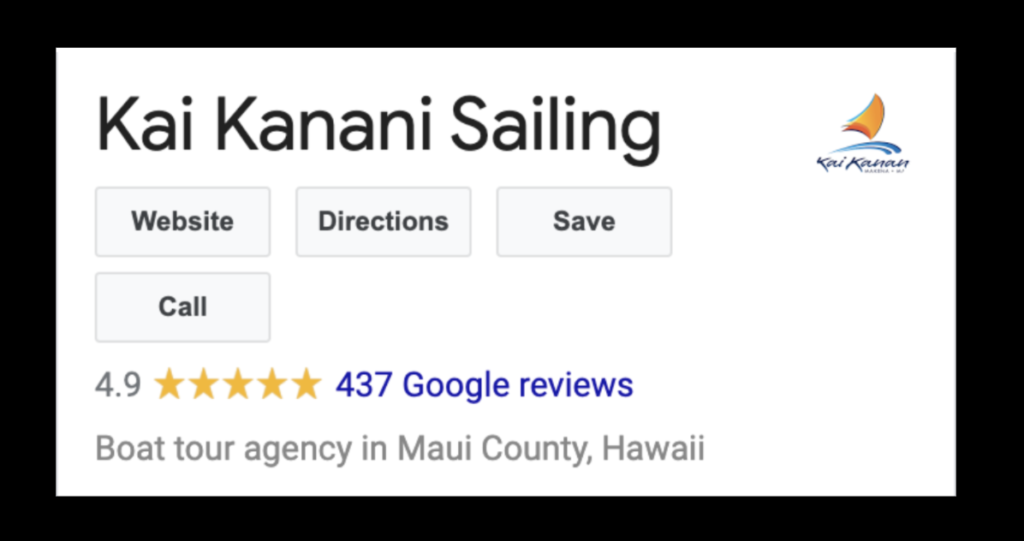
Google Maps Ranking Factors
If you want to rank higher on Google Maps, it’s not enough to just create a Google Business profile. You need to understand the ranking factors that Google Maps uses to determine which businesses show up at the top of the search results. Here are the top three ranking factors you should know about:
1. Relevance
This refers to how well your business listing matches the search terms used by potential customers. To increase your relevance, make sure your business profile includes accurate and descriptive information about your products or services. Use relevant keywords in your business description, categories, and reviews.
2. Distance
This ranking factor measures the proximity of your business to the user searching for your products or services. To improve your distance ranking, make sure your physical location is listed accurately on your Google Business profile. You can also include local landmarks or nearby attractions in your description to help improve your visibility for nearby searches.
3. Prominence
This ranking factor determines how well-known and reputable your business is in the local area. To increase your prominence, focus on building a positive online reputation by encouraging customers to leave reviews on your Google Business profile. You can also improve your prominence by being listed on other popular directories and online platforms.
Creating a Google Business Profile Account
Before you begin planning out your Google Maps marketing strategy, create a free Google Business Profile account. This account is necessary to manage and optimize your company’s Google Maps listing.
To create your Google Business Profile account,
- Head to the Google Business Profile landing page.
- Select “Sign in” and log in with your Google account.
- Search for your business name to claim its current listing or to create a new listing.
- Follow the prompts to input accurate business information into your listing.
If you need any assistance during this process, our guide to adding your company to Google Maps will provide you with helpful details about each step.
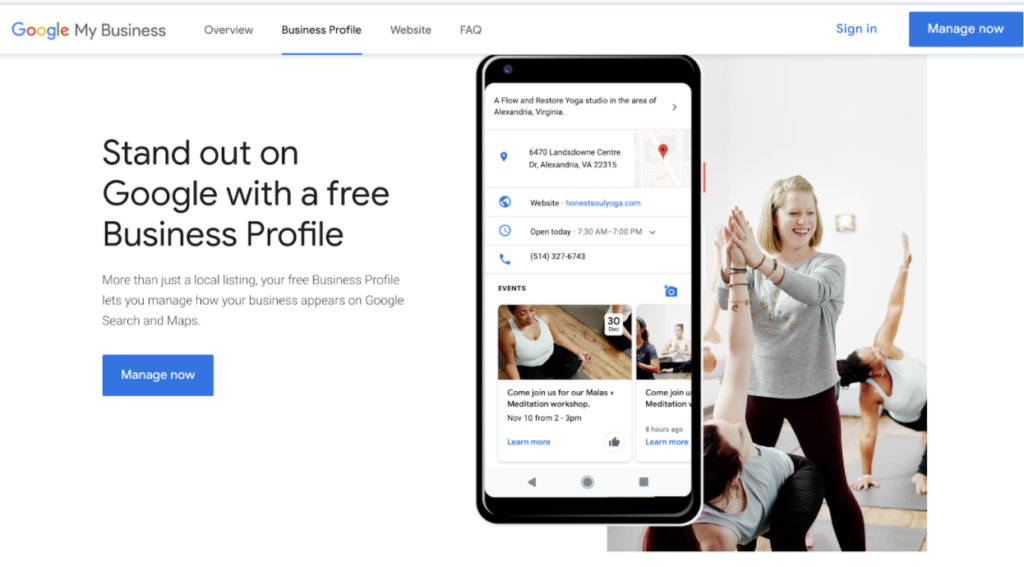
6 Google Maps Marketing Tips: Optimize Your Google Business Profile
Use the following location-based marketing practices on Google to quickly turn your business into the first destination—online and offline—for nearly all searchers. Since 92% of clicks on Google are made on the first page of results, getting your business on the first page can skyrocket your traffic.
Most brick-and-mortar business owners already know that Google Maps is a helpful way to provide basic information about your company and where you’re located. What will give your brand a leg up is understanding different ways to optimize your Google Business Profile for local SEO.
1. Fill in the blanks
The first and easiest way to improve your ranking is by fully filling out your company’s information on its Google business page. This requires you to enter the backend of your Google Business Profile and provide optional information. For example, you may add:
- Specific cities you service to improve your ranking for users located within those local markets.
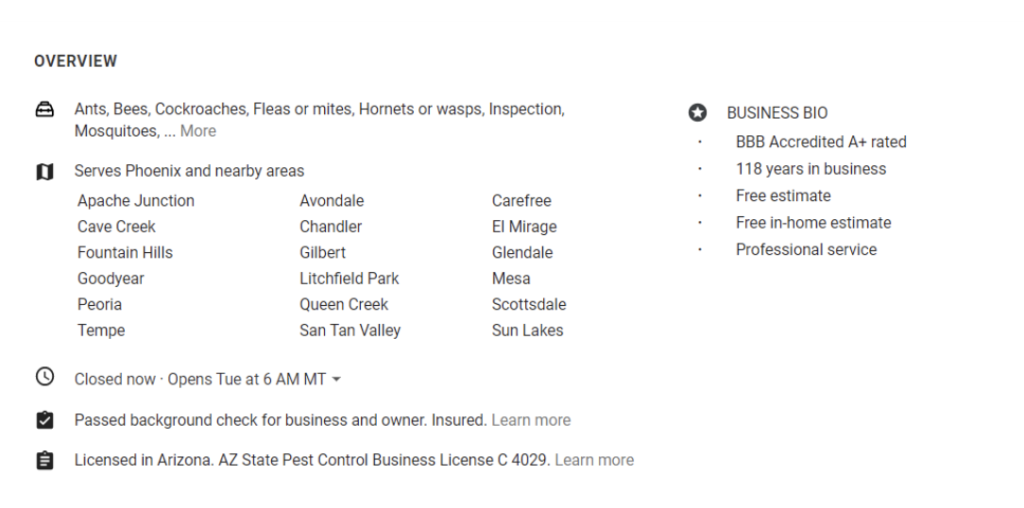
- Business categories to get ranked for commonly searched for and preset categories.
- Business hours to get listed for users searching for companies open at specific times.
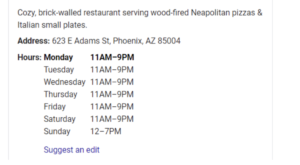
This is also a good time to double check that all of your information—including your phone number, business location, and other contact information—is completely accurate. Google gets its authority by delivering the best information to users possible, so having any incorrect details can hurt your rankings. For example, businesses in the United States that have their exact, standardized USPS address listed (proper abbreviations and all) can be listed higher than those that don’t.
While this may sound obvious, you’d be surprised by how many listings have inaccurate or outdated info, or info that is not being continuously monitored and updated. It’s important to check on your location details occasionally to ensure accuracy, and to make sure users haven’t tried to rename your business. While you are unlikely to get pranked by your customers or another business, one entertaining example of the importance of monitoring your listing is Hornsea Language College in the UK. According to local news, the school was briefly renamed “Hell on Earth” as a student joke.
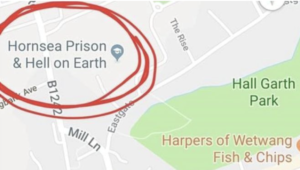
2. Add images
You should also include the use of images within your business listing in your Google maps marketing strategy. 32% of marketers say visual images are the most important form of content for their business, and Google Maps is no exception. No matter what type of business you own, attractive photos draw users’ eyes to your listing while giving you the chance to improve your Google Maps SEO.
You may be wondering how your SEO can improve if images don’t have any words? Well, images not having words doesn’t exactly have to be true on the internet. A common digital marketing strategy is adding metadata to your images to boost your ranking without making keywords directly visible to searchers.
If you upload a picture of your office or store taken on a mobile device, it may already have metadata about the physical location it was taken. With Google Maps, you can further add alt text that includes keywords, as well as location tags.

3. Collect Google reviews
While many Google searches are seeking out nearby locations for a specific type of product or service, you and your competitors will likely all be in close proximity to the searcher. Proximity is just one of many factors Google will use to display search results. In these cases, you can break the tie by ranking the highest in terms of ratings and reviews.
Google reviews are more important than ever. 88% of consumers say reviews influence them in discovering a local business. Approximately half of consumers are willing to travel farther and pay more to patronize a business with higher reviews. And it’s not just higher reviews, point blank, that get customers. When reading reviews, customers look for 1. Quality of service or product, 2. Good prices, and 3. Good customer service. 83% of consumers think that reviews must be recent and relevant in order to care about them, and 68% of consumers don’t trust a high review rating unless there is also a high quantity of reviews. Businesses need to aim for review quality, diversity, and management to compete.
While customer reviews aren’t the only factor in determining your rank on a search page, they do play a huge role in telling Google about your relevance in the area. They not only impact traditional search results, but drive your ranking up when locals search by relevance and rating.

To collect Google reviews:
1. Text. Over a third of consumers who receive a text review invite leave one, and approximately 41% of consumers prefer text to communicate vs. 18% who prefer email. If you want to increase your Google review collection, text is the key—and the results speak for themselves. After switching to text to collect reviews with Podium, Paul’s Pest Control jumped half a star on Google within 24 hours and gathered more reviews in one month than they had in five years.
2. Create a Google review link shortcut. The first step in setting up text review invites is to create a Google review link shortcut. This allows you to send customers messages with a short link that they can click to review you quickly and easily.
3. Manage reviews. If you want to collect reviews, it’s crucial to show your customers that reviews matter to you—and that means managing them. Respond to negative reviews within 2 hours and positive ones within 24 hours. Showing your customers that you are responsive and open to taking their feedback will make them more willing to leave you reviews.
4. Change according to reviews. Another great way to increase collection and demonstrate your responsiveness is to implement changes according to the feedback you receive. Ashley Furniture Homestore crushes the competition by continuously improving their business through the valuable feedback they get from their customers.
5. Use a reputation management platform. Managing, responding to, collecting, and analyzing reviews can be quite a task for any team to take on. But using the right reputation management platform makes it easy. After adopting a platform, Vasa tripled their reviews (jumping from 2.9 to 4.0 in star rating) in just three years. A platform such a Podium makes managing reviews successfully a breeze for any local business of any size.

4. Use keywords
Metadata isn’t the only place you can type in keywords. You can also add keywords to any customer-facing descriptions you type for your Google Maps listing. For example, if you’re a small business specializing in construction, you want your business to show up in local results for near me searches. In this example, you’d want to target and include search terms such as “contractor near me” and “builders in my area.”
When you are asked to create a short description for your business, try to fit in a few keywords that you want to rank for while still making the introduction natural. Do the same anywhere else you see fit, such as your “Categories” or “Labels” section.
For keyword research, start with service in location (SiL). This means taking all of the products or services you offer and adding “in [location]” to the end. For the construction example above, you’d start with “construction in New York,” or wherever your business is located. Then repeat for all of your services from framing to kitchen remodels and water damage repair.
When you’re done, your list of keywords could look like this:
- Contractor in New York City
- Kitchen remodel in New York City
- Water damage repair in New York City
- Design-build in New York City
- Construction management in New York City
- Interior build-out in New York City
If you’re having a hard time figuring out all of the keywords for your business, you can use a keyword generator tool. This one from Higher Visibility makes it easy to find all the relevant local search terms for your business.
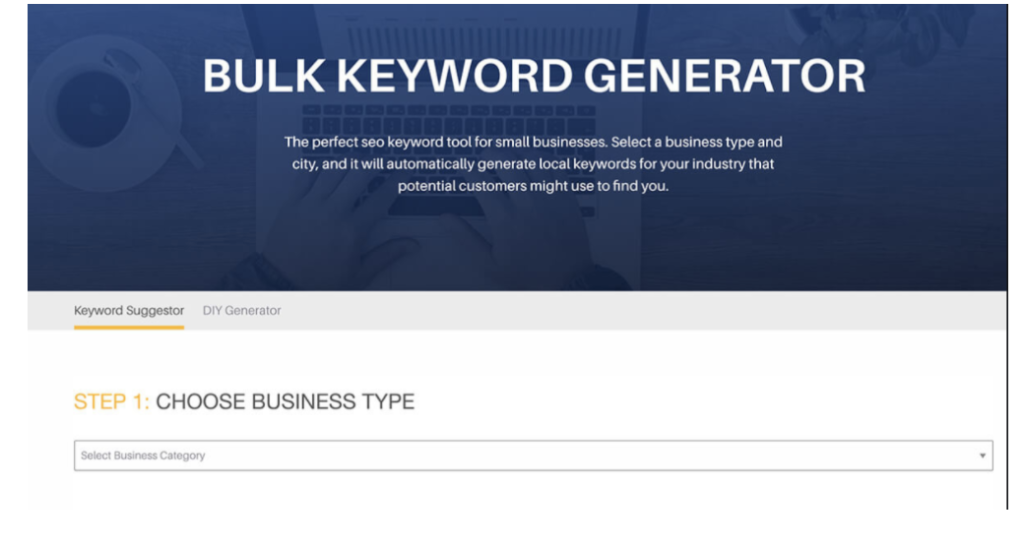
Just choose your type of local business from the drop-down menu, select the relevant service types, and add all of your service area locations. The tool will generate relevant local keywords specific to your business.
Another way to get local search keyword ideas is from Google’s auto-complete function. Anytime you type a search in the Google search bar, the website offers completion suggestions based on the most popular searches. Try searching for relevant terms about your business and see if Google offers any ideas you haven’t thought of.
Once you have your search terms, use a tool like the Keyword Explorer section in Ahrefs to check the keyword volume and keyword difficulty. Keyword volume indicates how many people are searching for those terms. Keyword difficulty shows how hard it is to rank for a specific search term. Prioritize keywords that have low difficulty and a high search volume.
5. Create local search ads
While Google Maps marketing can be a cost-free digital marketing effort, you can boost your online presence even more by using ads to drive potential customers to you.
Google’s local search ads can boost your business listing to the very top of Google Maps search results—even if your company isn’t as relevant as your competitors—on mobile and desktop.
The search engine states that when companies use local search ads, they are guaranteed to receive more store visits, phone calls, and clicks in general. You will have to pay a varying cost per click, (as this is a form of pay-per-click or PPC advertising), so it may be smart to test how effective this is for you before investing in these ads.

6. Verify your business
A final way for you to maximize your Google Maps marketing is verifying your business. Because Google wants to prevent any of their users from being scammed by businesses they recommend, the Google Maps app will often list verified results higher than those they’re unsure about.
While you have a number of options, many small businesses choose to verify by phone or email. When you verify by snail mail, you’ll receive a postcard at your business address with a code you can input in your Google Business Profile account.
Keep in mind that verifying your business will only be an effective SEO strategy if you’re pairing this effort with other methods we’ve listed above. However, it takes minimal effort and its effectiveness includes casting you as a legitimate business to locals and Google without requiring any updates in the future.
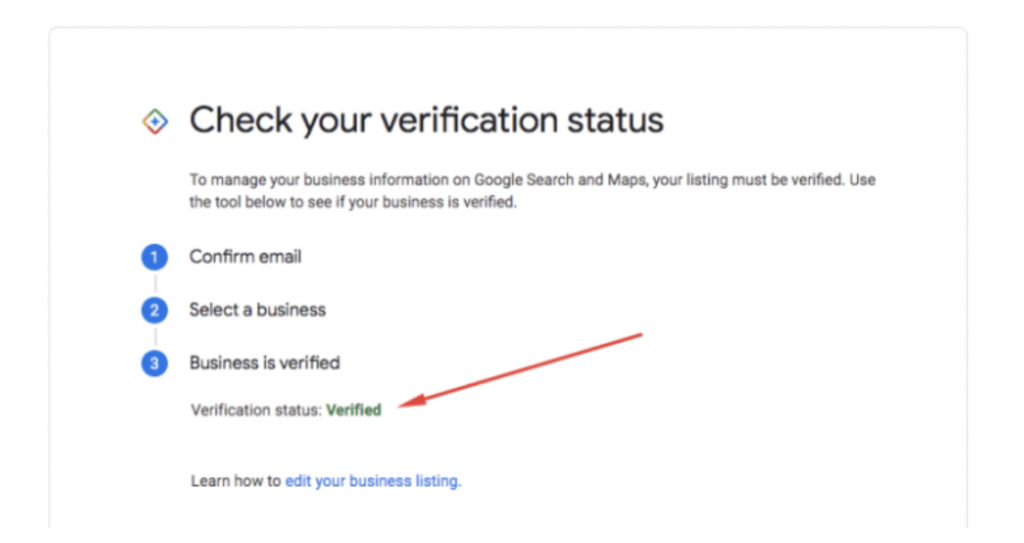
Effective Google Maps Marketing Examples
So, having an optimized Google Business Profile is key. Reading about optimizing your profile is one thing, but what does a good profile actually look like? Here are a couple of examples.
1. The Halal Guys
This popular fast food chain has a clean and organized Google Business Profile that includes their address, phone number, website, and hours of operation. But what really sets it apart is the eye-catching photos of their food and the many positive customer reviews they’ve earned.

2. Vinnie’s Pizza
This pizza place in New Jersey has a creative and engaging Google Business Profile that includes tons of pictures of their food and restaurant, as well as a Questions & Answers section that provides information about their services. They’ve also earned a lot of positive reviews from satisfied customers.
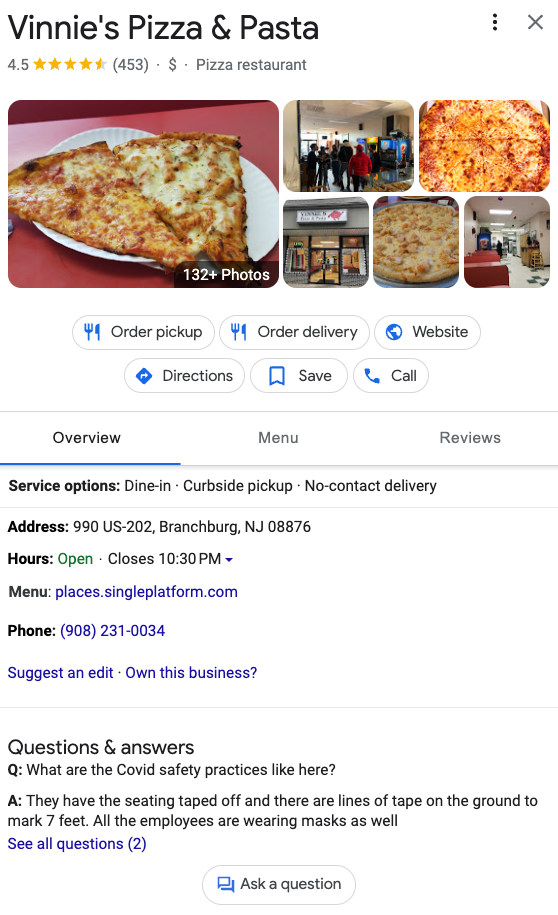
Connect with more customers
With over 154 million users, Google Maps marketing is one of the most important aspects of local marketing. When you turn your company’s Google Maps listing into an ultimate guide to your services and how to access them, you’ll see a rise in not only leads, but conversion and revenue as well.
If you want to increase your conversion and revenue even more, Podium can help. Following these tips and connecting your Google Business Profile account to Podium will increase your clicks to call by over 85% and your website visits by over 67%. See what Podium can do for your business free with Podium Starter.
This article is part of our Google Reviews Explained Guide:
Google Reviews 101
- 5 Powerful Advantages of Google Reviews
- Do Google Reviews Help Rankings?
- Does Google Business Profile matter in 2020?
- The Importance of Reviews in Your Adwords
- Google Knowledge Panel Updates Local Business Reviews
- How to Leave a Google Review
- How to delete a Google Review
Google Reviews Related Training
















